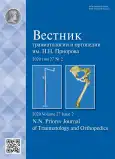Оценка иммунологической реакции организма на сплавы металлов эндопротеза по маркерным структурам сыворотки крови
- Авторы: Шатохина С.Н.1, Зар В.В.1, Зар М.В.2, Шабалин В.Н.3
-
Учреждения:
- Государственное бюджетное учреждение здравоохранения Московской области «Московский областной научно-исследовательский клинический институт имени М.Ф. Владимирского»
- Федеральное государственное бюджетное научное учреждение «Научно-исследовательский институт общей патологии и патофизиологии»
- Федеральное государственное бюджетное научное учреждение «Научно-исследовательский институт общей патологии и патофизиологии»
- Выпуск: Том 27, № 2 (2020)
- Страницы: 30-34
- Раздел: Оригинальные исследования
- URL: https://bakhtiniada.ru/0869-8678/article/view/34277
- DOI: https://doi.org/10.17816/vto202027230-34
- ID: 34277
Цитировать
Полный текст
Аннотация
С целью выяснения причин воспалительной реакции с последующим фиброзированием во втором оперированном суставе у пациентки с двусторонним гонартрозом проведено исследование твердофазных структур сыворотки крови методами клиновидной и краевой дегидратации (технология «Литос-Система»). Исследование было направлено на выявление специфических морфологических маркеров, характеризующих реакцию организма на материал эндопротеза. При суточной инкубации сыворотки крови со сплавом титана, алюминия и ванадия ее твердофазные структуры свидетельствовали об активации гиперэргической реакции, а при инкубации со сплавом кобальта, хрома и молибдена, напротив, — на подавление иммунологической активности сыворотки крови и трансформацию присутствующих в ней структур в аморфный детрит. Установлено, что характер иммунологической реакции сенсибилизированного организма зависит от вида металлов, входящих в состав эндопротеза. На сплав титана, алюминия и ванадия иммунная реакция вызывает воспаление околосуставной ткани с последующим ее фиброзированием и образованием рубцовой демаркационной оболочки, отделяющей околосуставные ткани от эндопротеза и выполняющей функцию иммунологического барьера. На сплав кобальта, хрома и молибдена иммунологическая реакция вызывает деструкцию воспаленной околосуставной ткани с последующим постепенным разрушением суставной сумки.
Полный текст
Открыть статью на сайте журналаОб авторах
Светлана Николаевна Шатохина
Государственное бюджетное учреждение здравоохранения Московской области «Московский областной научно-исследовательский клинический институт имени М.Ф. Владимирского»
Автор, ответственный за переписку.
Email: sv_n@list.ru
ORCID iD: 0000-0001-9441-4383
д-p мед. наук, профессор, заведующая кафедрой клинической лабораторной диагностики факультета усовершенствования врачей
Россия, МоскваВадим Владимирович Зар
Государственное бюджетное учреждение здравоохранения Московской области «Московский областной научно-исследовательский клинический институт имени М.Ф. Владимирского»
Email: vzar@list.ru
канд. мед. наук, ведущий научный сотрудник отделения травматологии и ортопедии, доцент кафедры травматологии и ортопедии факультета усовершенствования врачей
Россия, МоскваМихаил Вадимович Зар
Федеральное государственное бюджетное научное учреждение«Научно-исследовательский институт общей патологии и патофизиологии»
Email: vzar@list.ru
ординатор кафедры травматологии и ортопедии факультета усовершенствования врачей
Россия, МоскваВладимир Николаевич Шабалин
Федеральное государственное бюджетное научное учреждение «Научно-исследовательский институт общей патологии и патофизиологии»
Email: shabalin.v2011@yandex.ru
ORCID iD: 0000-0002-1861-759X
д-p мед. наук, профессор, академик РАН, главный научный сотрудник лаборатории биокристалломики
Россия, МоскваСписок литературы
- Hallab N, Merritt K, Jacobs JJ. Metal sensitivity in patients with orthopaedic implants. J Bone Joint Surg Am. 2001;83(3):428-436. https://doi.org/10.2106/00004623-200103000-00017.
- Granchi D, Cenni E, Giunti A, Baldini N. Metal hypersensitivity testing in patients undergoing joint replacement: a systematic review. J Bone Joint Surg Br. 2012;94(8):1126-1134. https://doi.org/10.1302/0301-620X.94B8.28135.
- Thakur RR, Ast MP, McGraw M, Bostrom MP, Rodriguez JA, Parks ML. Severe persistent synovitis after cobalt-chromium total knee arthroplasty requiring revision. Orthopedics. 2013;36(4):e520-e524. https://doi.org/10.3928/01477447-20130327-34.
- Шабалин В.Н., Шатохина С.Н. Функциональная морфология неклеточных тканей человека. М.: РАН; 2019. 356 c. [Shabalin VN, Shatokhina SN. Funktsional’naya morfologiya nekletochnykh tkanei cheloveka. Moscow: RAN; 2019. 356 p. (In Russ.).]
- Шатохина С.Н., Шабалин В.Н. Атлас структур неклеточных тканей человека в норме и патологии. Т. 2. Морфологические структуры сыворотки крови. Тверь: Триада; 2013. C. 74-87. [Shatokhina SN, Shabalin VN. Atlas struktur nekletochnykh tkanei cheloveka v norme i patologii. Vol. 2. Morfologicheskie struktury syvorotki krovi. Tver: Triada; 2013. P. 74-87. (In Russ.).]
Дополнительные файлы









